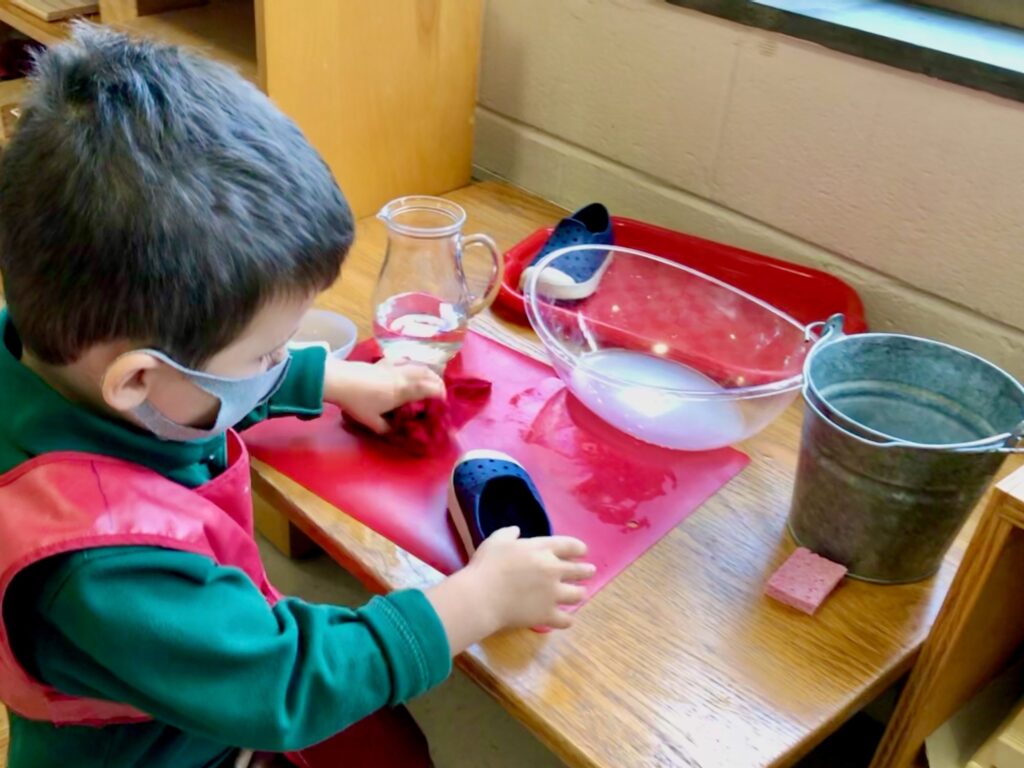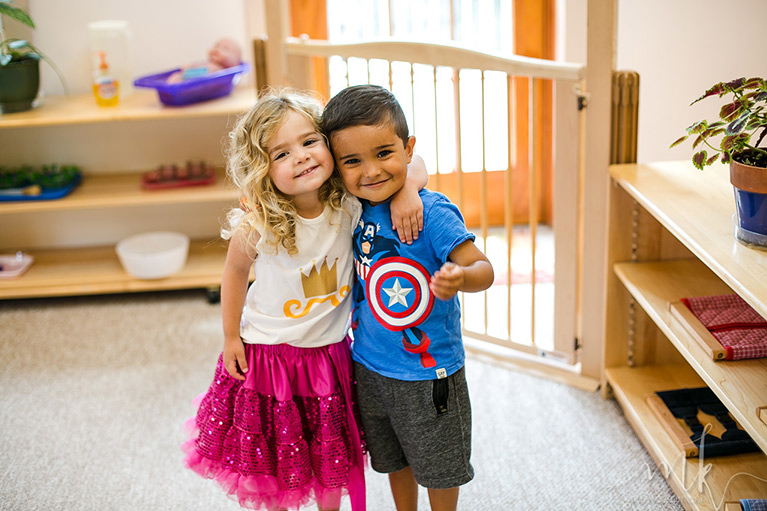Ah, the temper tantrum. Read any parenting list, and you’ll find many requests for advice on how to manage children’s temper tantrums. Tantrums seem like a force of nature, something we just have to deal with as parents of toddlers and preschoolers.
To some extent, that’s certainly true: young children are learning what it means to feel upset, and many times, there is nothing we can do to prevent their frustration. Yet when I observe in Montessori toddler classrooms, I am struck by how rare tantrums are; after an initial transition period, ongoing bouts of intense, heart-wrenching crying are all but absent from a Montessori environment. Of course, there are conflicts, and of course, children experience negative emotions—these experiences are a natural part of life, and something a child learns to manage, not eliminate. What’s rare in a good Montessori program is the type of rage we as parents may encounter at home.
What are Montessori teachers doing to create such a peaceful, happy environment—and can we as non-Montessori trained parents apply some of their secrets at home?

Supporting your child’s sense of order.
Maria Montessori observed that young children often get agitated when even little things in their lives are out of place. If we always start the bath by washing our baby’s body first, and head second, and then absent-mindedly reverse the order one day, we may find our toddler inconsolable. Whether or not we can identify it, the source of frustration is very often a broken routine. A snack in a new container; a different seat at the table; a toy that cannot be found; an interruption in play to head to an appointment: these all may be so minor to us that we don’t even notice them, but for a toddler, these small things can set off a major reaction, a seemingly “causeless” tantrum that in fact is caused by a disruption of our child’s developing sense of order.
In a Montessori classroom, teachers deliberately accommodate a young child’s need for order. Materials are displayed on low shelves, and each has its special spot. The day follows a clear, consistent routine: outside time, then coming back inside, washing hands, having snack, then work period, and so on. Writes Dr. Montessori:
Order is one of the needs of life which, when it is satisfied, produces a real happiness. In fact, in our schools, even older children, those three- or four-years old, after finishing an exercise will put the things they have used back in place. … Order consists in recognizing the place for each object in relation to its environment and in remembering where each thing should be. This implies that one is able to orient one’s self within one’s environment and to dominate it in all its details.

Children are just discovering their world. It is largely a mysterious place, where things are wondrous and at times scary. Being able to have a space that is safe, where things are predictable and in their control, is essential for their mental well-being, and helps prevent many tantrums.
- Have clear, consistent routines—for getting up and getting dressed, for eating, for playtime, for transitions, for getting in and out of the car. Follow these routines, particularly when there are other upheavals in life (a new baby, a relative visiting, the start of school).
- Simplify the play area. Invest in some open shelves (Ikea has cheap, good ones), and display only a small number of items, each in its proper spot.
- Take time to observe your child. Be on the lookout for violations of order that might have caused a tantrum—like a toy put away prematurely, or a step in a routine that was omitted in haste.
- Prepare your child for changes in routine. If you’re going to have dinner outside in the yard rather than at the table, mention that in advance, and if possible involve your child in a transitional activity such as helping to take placemats outside.
[Of course, our toddlers will experience big emotions no matter what we do. If that happens, our role is to be an empathetic listener, to help them name their emotions and to provide reassurance that we are not rattled by the behavior. This blog provides good pointers!

Fostering independence, fostering family peace.
Toddlers are often in conflict with themselves and others: they want to do things on their own, like pouring a drink or putting on their socks, but they just cannot (yet) do it. Many tantrums are due to this frustration, this urgent wanting to be capable, be big, but finding it’s not possible.In a Montessori classroom, we help toddlers become competent by taking the time to teach key skills in small, manageable steps. For example, we use dressing frames to help children learn how to zip a zipper or button a coat. We practice pouring solids (like lentils) with small containers as a preparation for ultimately pouring one’s own drink. You can help your toddler feel more capable and confident at home, too, by setting up your home for independence, and teaching skills step-by-step.
When your child is able to put on his own coat with the “Montessori throw”, when he can get his own drink or snack, instead of needing your help every step of the way, he’s going to be a happier child, less frustrated and more joyful to live with!

The work rug secret
Many conflicts between children arise over the sharing of toys. Susie has a toy, and Max wants it. Someone is going to be frustrated; often, an adult intervenes and encourages “sharing”.In a Montessori classroom, we have a simple rule that prevents many of these conflicts: children may only work with one activity at a time, and need to put it back in its proper place on the shelf when done. No child may grab a toy from another child, but as soon as an item is back on a shelf, the waiting child may take it. Children can work on small tables, or they can roll out a rug on the floor to designate their workspace. Through active modeling, we teach children to respect each other’s personal space, to walk around (not over) rugs, and to watch others working by standing at a respectful distance, hands behind their backs.A similar approach can also work at home.
When consistently applied, these types of simple rules ensure each child’s personal space is respected. An established, predictable right to uninterrupted play goes a long way toward fostering a respectful, benevolent atmosphere when multiple children play in the same space, whether at home or at school.

Being a toddler is hard work! Even with these approaches in place, children will experience challenging emotions: they may be frustrated at the need to wait for a toy, or face an unavoidable break in their routine. We can help them weather the storm by proactively offering words to identify their big feelings: “You really want to have the blocks right now, and it’s making you angry that Suzie has them”, or “You’d love to put your coat on all by yourself, but the sleeve is stuck. Here, let’s pull out the sleeve, and you can try again.”
When we respect our toddler’s need for order, independence, and personal space, when we help him name and express their big feelings, we can make huge strides in making toddler time less tantrum prone and more enjoyable for the entire family.


